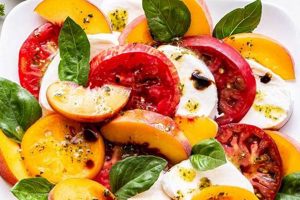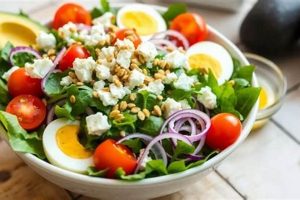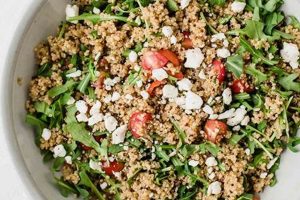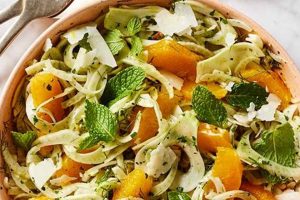A refreshing and flavorful Levantine dish, this parsley-based salad features finely chopped vegetables, bulgur wheat, and a vibrant lemon-herb dressing. Common additions include tomatoes, mint, onion, and cucumber. Variations exist across the Levant and beyond, with some regions favoring more parsley, while others incorporate different grains or herbs.
This salad provides a wealth of nutritional benefits, being a significant source of vitamins, antioxidants, and fiber. Historically enjoyed as part of a mezze platter, its versatility allows it to complement various cuisines and dietary preferences. It serves as a light yet satisfying meal on its own or as a vibrant accompaniment to grilled meats, fish, or falafel.
This exploration will delve into diverse preparation methods, regional variations, and tips for achieving optimal flavor and texture. Further discussion will cover ingredient selection, nutritional information, and suggestions for integrating this versatile dish into a balanced diet.
Tips for Perfect Preparation
Achieving optimal flavor and texture requires attention to detail and an understanding of key ingredients. The following tips offer guidance for creating a truly exceptional culinary experience.
Tip 1: Soaking the Bulgur: Fine-grain bulgur is preferred. Soaking, rather than cooking, preserves texture and prevents a mushy consistency. Use cold water and allow the bulgur to absorb the liquid until tender.
Tip 2: Parsley as the Star: Flat-leaf parsley should be the dominant ingredient, providing a fresh, herbaceous foundation. Finely chop the parsley to release its vibrant flavor.
Tip 3: Balancing the Herbs: While parsley takes center stage, mint offers a complementary aromatic dimension. Use a smaller quantity of mint to avoid overpowering the parsley.
Tip 4: Vegetable Selection and Preparation: Ripe, flavorful tomatoes and crisp cucumbers contribute essential texture and taste. Finely dice all vegetables for uniform consistency and optimal integration.
Tip 5: The Art of the Dressing: Freshly squeezed lemon juice is paramount. A balance of tangy lemon, extra virgin olive oil, and a touch of salt creates a vibrant dressing that enhances the other ingredients.
Tip 6: Resting Period: Allowing the salad to rest for at least 30 minutes, or preferably longer, allows the flavors to meld and deepen. This crucial step enhances the overall taste experience.
Tip 7: Ingredient Quality: The freshest, highest quality ingredients yield the best results. Opt for locally sourced produce whenever possible.
By adhering to these guidelines, one ensures a vibrant, flavorful, and authentic culinary creation. Attention to detail in each step elevates this simple salad to a truly exceptional dish.
These insights provide a comprehensive understanding of the nuances of preparation. The following section will offer variations and serving suggestions.
1. Fresh Ingredients
The vibrancy and flavor of tabouli salad rely heavily on the freshness of its components. Fresh parsley, specifically flat-leaf parsley, provides the herbaceous foundation of the dish. Its bright, slightly peppery flavor is essential and cannot be replicated by dried alternatives. Similarly, fresh mint offers a cooling counterpoint to the parsley, but only when used in its freshest form. Dried mint tends to have a less nuanced, almost medicinal taste, which detracts from the overall balance. The tomatoes and cucumbers also contribute significantly to the salad’s freshness. Ripe, juicy tomatoes offer a burst of sweetness and acidity, while crisp cucumbers provide a refreshing crunch. Using less-than-fresh produce results in a dull, watery salad that lacks the characteristic vibrancy. For example, using a mealy tomato will negatively impact the texture and flavor profile of the entire dish.
Beyond the core ingredients, the dressing also benefits from fresh components. Freshly squeezed lemon juice provides a bright, citrusy tang that complements the herbs and vegetables. Bottled lemon juice often contains preservatives and lacks the same vibrancy. Furthermore, high-quality extra virgin olive oil adds a subtle fruitiness and richness to the salad. These fresh ingredients, when combined, create a synergistic effect, resulting in a salad that is greater than the sum of its parts. Imagine the contrast between a tabouli salad made with freshly picked herbs from a garden versus one made with wilted, store-bought herbs. The difference is palpable, impacting not only the taste but also the overall sensory experience.
In conclusion, the emphasis on fresh ingredients in tabouli salad is not merely a preference but a necessity. The interplay of fresh herbs, ripe vegetables, and a vibrant dressing defines this classic dish. Substituting fresh ingredients with processed or less-than-optimal alternatives compromises the integrity and intended flavor profile. Understanding this connection between freshness and flavor is paramount for anyone seeking to create an authentic and truly delicious tabouli salad. This underscores the importance of sourcing the highest quality ingredients possible and preparing them with care. While some substitutions may be permissible in other culinary contexts, compromising on freshness in tabouli significantly diminishes the final product.
2. Proper Bulgur Preparation
Proper bulgur preparation is crucial for achieving the desired texture and flavor in tabouli salad. Bulgur, a staple ingredient, contributes a nutty flavor and satisfying chewiness. However, improper preparation can result in a mushy, unpleasant texture that detracts from the overall experience. The most common mistake is cooking bulgur as one would cook rice. While boiling might seem like a logical approach, it often leads to overcooked, sticky grains. The ideal method involves soaking the bulgur in cold water. This gentle hydration process allows the grains to soften and expand while retaining their distinct shape and texture. The absorption method also ensures that the bulgur absorbs the flavors of the dressing more effectively, resulting in a more harmonious blend of tastes.
Consider two scenarios: in the first, bulgur is boiled for an extended period. The resulting grains are soft, mushy, and clump together, creating a heavy, dense salad. In the second scenario, the same type of bulgur is soaked in cold water until tender. The grains remain separate and distinct, offering a light, fluffy texture that complements the other ingredients. This difference in texture significantly impacts the overall enjoyment of the salad. For example, a tabouli salad made with properly soaked bulgur holds its shape well, making it ideal for packing in lunches or serving as part of a buffet. Conversely, tabouli made with overcooked bulgur quickly becomes a soggy mess, unsuitable for these purposes.
Understanding the importance of proper bulgur preparation is essential for anyone seeking to create an authentic and enjoyable tabouli salad. Soaking, rather than boiling, ensures the optimal texture and flavor of this key ingredient. This seemingly small detail can significantly elevate the final dish, transforming it from a mediocre experience to a truly delightful culinary creation. This attention to detail reflects a broader appreciation for the nuances of flavor and texture that characterize well-executed cuisine. Failure to prepare the bulgur correctly undermines the balance and harmony of the salad, highlighting the interconnectedness of each component in the final composition.
3. Herb Ratios
Herb ratios play a pivotal role in defining the characteristic flavor profile of tabouli salad. Parsley, the dominant herb, provides a fresh, herbaceous base. Mint, used in a smaller quantity, adds a cooling, aromatic counterpoint. The interplay between these two herbs creates a complex flavor dynamic that distinguishes tabouli from other salads. An improper balance can lead to a salad that is either overwhelmingly minty or lacking in complexity. For example, a tabouli salad with too much mint can taste like toothpaste, masking the delicate flavor of the parsley and other vegetables. Conversely, too little mint results in a one-dimensional flavor profile, missing the refreshing brightness that mint provides. Achieving the correct balance requires understanding the distinct characteristics of each herb and their synergistic relationship within the salad.
The traditional ratio emphasizes parsley as the star, with a significantly larger proportion compared to mint. This ratio ensures that the parsley’s herbaceousness shines through, while the mint provides a subtle, complementary layer of flavor. Specific ratios vary based on regional preferences and individual tastes, but the principle of parsley dominance remains consistent. Consider a recipe calling for two cups of chopped parsley and two tablespoons of chopped mint. This ratio exemplifies the emphasis on parsley while still incorporating the refreshing element of mint. Altering this ratio significantly, for example, using equal parts parsley and mint, dramatically changes the flavor profile, resulting in a salad that deviates from the traditional taste. This demonstrates the practical significance of understanding herb ratios in achieving the authentic tabouli flavor.
Mastering herb ratios is essential for creating a balanced and flavorful tabouli salad. The interplay between parsley and mint defines the characteristic taste of this dish. Attention to these seemingly small details elevates the salad from a simple combination of ingredients to a complex and nuanced culinary creation. Challenges arise when recipes lack specific measurements or when individual palates prefer variations. However, understanding the underlying principle of parsley dominance allows for informed adjustments while maintaining the integrity of the traditional flavor profile. This knowledge empowers individuals to adapt recipes to their preferences while still achieving a recognizable and enjoyable tabouli experience. This mastery underscores the importance of precision and balance in culinary arts, highlighting the interconnectedness of ingredients and their impact on the final dish.
4. Flavorful Dressing
A flavorful dressing is paramount to a successful tabouli salad, acting as a unifying element that binds the individual components and elevates the overall taste experience. This dressing, typically a simple emulsion of extra virgin olive oil, freshly squeezed lemon juice, and salt, provides the essential acidic and savory notes that balance the herbaceousness of the parsley and mint, the sweetness of the tomatoes, and the subtle bitterness of the onion. The dressing not only coats the ingredients but also penetrates them, infusing each element with its vibrant flavor. For instance, imagine tasting tabouli without the dressing a bland, disjointed mix of chopped vegetables and herbs. The dressing transforms this mixture into a cohesive, flavorful salad. The quality of the ingredients in the dressing is crucial. Freshly squeezed lemon juice offers a brightness and complexity that bottled lemon juice lacks. High-quality extra virgin olive oil contributes a subtle fruitiness and a rich mouthfeel. The precise ratio of these ingredients also impacts the final flavor. Too much lemon juice can make the salad overly tart, while too little can leave it tasting flat. A properly balanced dressing enhances, rather than overpowers, the natural flavors of the other ingredients.
The practical significance of this understanding lies in the ability to adjust the dressing to individual preferences and specific ingredient combinations. If using sweeter tomatoes, a slightly higher proportion of lemon juice might be desirable. If the parsley is particularly pungent, a touch more olive oil can mellow the flavor. This flexibility allows for customization while maintaining the core principles of a balanced and flavorful dressing. The impact extends beyond mere taste. The dressing also contributes to the overall texture of the salad. The olive oil coats the herbs and vegetables, giving them a glistening appearance and preventing them from drying out. This ensures a pleasant, fresh mouthfeel throughout the meal. Consider a scenario where the dressing is too acidic or too oily. This imbalance can negatively affect the palatability of the salad, making it either too tart or too heavy. A well-balanced dressing, on the other hand, creates a harmonious blend of flavors and textures, enhancing the overall dining experience.
In conclusion, the flavorful dressing in tabouli salad is not merely a condiment but an integral component that contributes significantly to its overall appeal. The careful selection of ingredients, their precise ratios, and their interaction with the other components of the salad create a synergistic effect, resulting in a dish that is both refreshing and complex. Challenges arise when using subpar ingredients or when neglecting the delicate balance required. Overlooking the importance of the dressing can lead to a disappointing culinary outcome, highlighting the interconnectedness of all elements within the dish. Mastery of this element elevates the tabouli salad from a simple combination of ingredients to a truly exceptional culinary creation, demonstrating the power of a well-crafted dressing in transforming a dish.
5. Resting Time
Resting time is a critical, often overlooked, element in tabouli salad preparation. This period, ideally a minimum of 30 minutes, allows the flavors of the various componentsthe herbs, vegetables, bulgur, and dressingto meld and harmonize. A freshly mixed tabouli salad, while seemingly vibrant, lacks the depth and complexity that develops during the resting period. The lemon juice in the dressing begins to soften the vegetables slightly, releasing their juices and allowing them to mingle with the herbs and bulgur. The bulgur absorbs the flavors of the dressing, becoming more flavorful and less grainy. The herbs, initially bright and assertive, mellow and integrate with the other components. This transformative process, driven by osmosis and diffusion, elevates the salad from a simple mixture of ingredients to a cohesive, unified dish. Consider, for example, the difference between a freshly brewed cup of tea and one that has steeped for a few minutes. The steeping process allows the flavors to develop fully, resulting in a richer, more complex beverage. Similarly, resting time allows the flavors of the tabouli salad to mature and deepen.
The practical significance of this understanding is readily apparent. A tabouli salad prepared several hours in advance or even the day before often tastes superior to one made immediately before serving. This makes it an ideal dish for meal prepping or entertaining. Imagine a scenario: two identical tabouli salads are prepared. One is served immediately, while the other is allowed to rest for an hour. The rested salad exhibits a more balanced flavor profile, with the individual components harmonizing rather than competing. The textures are also subtly enhanced, with the bulgur becoming more tender and the vegetables slightly softened. This demonstrably superior outcome underscores the importance of incorporating resting time into the preparation process. Neglecting this step results in a salad that, while edible, lacks the depth and complexity that characterize a well-made tabouli.
In conclusion, resting time is not merely a passive waiting period but an active, essential stage in tabouli salad preparation. It is during this period that the flavors meld, the textures refine, and the individual components transform into a unified, harmonious whole. Challenges arise when time constraints necessitate serving the salad immediately. However, even a brief resting period of 15-20 minutes can noticeably improve the final product. Recognizing the importance of resting time underscores a deeper understanding of culinary principles and the transformative power of time in enhancing flavor and texture. This insight elevates the tabouli salad from a simple dish to a testament to the importance of patience and attention to detail in achieving culinary excellence.
Frequently Asked Questions
This section addresses common inquiries regarding tabouli salad preparation and variations.
Question 1: Can quinoa be substituted for bulgur?
Quinoa can be substituted, offering a different nutritional profile and slightly altered texture. However, this substitution deviates from the traditional recipe.
Question 2: How long can tabouli salad be stored?
Properly stored in an airtight container in the refrigerator, it typically lasts for three to five days. Optimal flavor is experienced within the first two days.
Question 3: Is cracked wheat the same as bulgur?
While related, they differ in processing. Bulgur is parboiled, dried, and then cracked, while cracked wheat is simply cracked wheat kernels. Bulgur is preferred for tabouli.
Question 4: Can other herbs be added to tabouli salad?
While parsley and mint form the traditional base, small amounts of other herbs, such as dill or cilantro, can be incorporated for nuanced flavor variations.
Question 5: What are common serving suggestions for tabouli?
It is often served as part of a mezze platter, alongside hummus, falafel, and pita bread. It also complements grilled meats, fish, or vegetable dishes.
Question 6: How can one adapt the recipe for dietary restrictions, such as veganism or gluten intolerance?
Traditional recipes are naturally vegan. For gluten intolerance, ensure that the bulgur is certified gluten-free, as some varieties may contain trace amounts of gluten.
These responses offer practical guidance for navigating common questions encountered during tabouli preparation. Addressing these points ensures a successful and enjoyable culinary experience.
Further exploration of regional variations and cultural context follows in the next section.
Tabouli Salad Recipes
This exploration of tabouli salad recipes has delved into the essential components and techniques that contribute to its distinctive character. From the importance of fresh, high-quality ingredients to the precise balance of herbs and the crucial resting period, each step plays a vital role in the final outcome. Proper bulgur preparation ensures optimal texture, while a vibrant, balanced dressing elevates the flavors of the herbs and vegetables. Understanding these fundamental elements empowers individuals to create a truly authentic and delicious tabouli salad experience. Regional variations offer further opportunities for culinary discovery, showcasing the adaptability and enduring appeal of this classic dish.
Tabouli salad, far from being a simple mixture of ingredients, represents a testament to the power of culinary craftsmanship. Attention to detail, an appreciation for fresh ingredients, and an understanding of the subtle interplay of flavors and textures elevate this dish to a culinary art form. Continued exploration of regional variations and personal adaptations promises to further enrich the culinary landscape, ensuring the enduring legacy of tabouli salad for generations to come.






